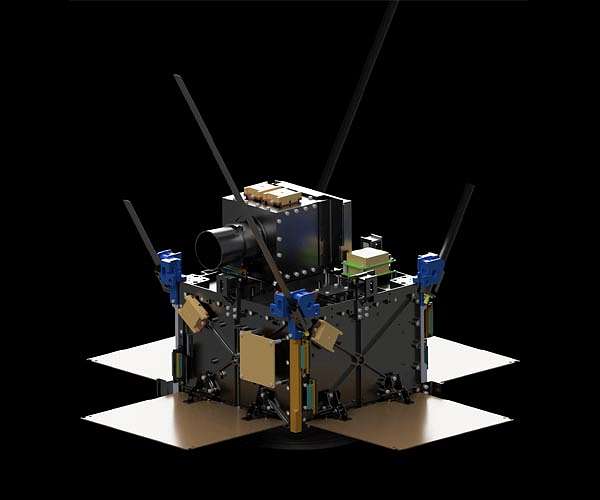- Joined
- 25 June 2009
- Messages
- 13,748
- Reaction score
- 2,936
Prototype Hyperspectral Satellite Fast-Tracked to Begin Official Spy Work for Military
By Rebecca Boyle
Popular Science
June 11, 2010
After a year of tests, a hyperspectral spy satellite is being called into service this weekend as a military reconnaissance tool, the Air Force says.
The Tactical Satellite-3, or TacSat-3, uses hyperspectral imaging to identify objects of interest in the ground and supply coordinates for them. Within 10 minutes of passing overhead, laptop-sized ground terminals can mark points of interest for combat troops, as the Register reports.
In its 13-month experimental flight, TacSat-3 assisted with earthquake relief efforts in Haiti and Chile, and took more than 2,100 photos with its Advanced Responsive Tactically Effective Military Imaging Spectrometer, or ARTEMIS.
Everything on the Earth's surface is being stimulated by energy from the Sun, and that causes everything to emit special spectral fingerprints. Hyperspectral sensors detect all those fingerprints. On board TacSat-3, complex computers sift through ARTEMIS' data, determining what the fingerprints represent and whether any of the objects or substances could be a target. There's no hiding from its prying eyes -- tricks that would defy optical or thermal sensors don't work with hyperspectral imaging.
After determining the nature of its targets, TacSat-3 beams coordinates to ground-based terminals, and troops can start marking plans.
TacSat-3 will start tactical operations Saturday, according to the Air Force Research Laboratory. TacSat-3 is part of the military's Operationally Responsive Space program, which seeks fast, flexible and cheap space-based support systems. Ideally, a military user can make a request and have a small tactical satellite in orbit within days, rather than months or years. TacSat-3 only weighs 880 pounds and was designed on a modular bus, meaning its body type can be used again.
As the Register notes, it's unusual for a military prototype to be but into service so quickly. But it was apparently very good at its job.
Just what sorts of objects and substances ARTEMIS is able to pick out is a military secret. But a 2006 AFRL document suggests that it could spot cave or tunnel entrances invisible from above, among other abilities.
Source: http://integrator.hanscom.af.mil/2010/June/06172010/06172010-10.htm
By Rebecca Boyle
Popular Science
June 11, 2010
After a year of tests, a hyperspectral spy satellite is being called into service this weekend as a military reconnaissance tool, the Air Force says.
The Tactical Satellite-3, or TacSat-3, uses hyperspectral imaging to identify objects of interest in the ground and supply coordinates for them. Within 10 minutes of passing overhead, laptop-sized ground terminals can mark points of interest for combat troops, as the Register reports.
In its 13-month experimental flight, TacSat-3 assisted with earthquake relief efforts in Haiti and Chile, and took more than 2,100 photos with its Advanced Responsive Tactically Effective Military Imaging Spectrometer, or ARTEMIS.
Everything on the Earth's surface is being stimulated by energy from the Sun, and that causes everything to emit special spectral fingerprints. Hyperspectral sensors detect all those fingerprints. On board TacSat-3, complex computers sift through ARTEMIS' data, determining what the fingerprints represent and whether any of the objects or substances could be a target. There's no hiding from its prying eyes -- tricks that would defy optical or thermal sensors don't work with hyperspectral imaging.
After determining the nature of its targets, TacSat-3 beams coordinates to ground-based terminals, and troops can start marking plans.
TacSat-3 will start tactical operations Saturday, according to the Air Force Research Laboratory. TacSat-3 is part of the military's Operationally Responsive Space program, which seeks fast, flexible and cheap space-based support systems. Ideally, a military user can make a request and have a small tactical satellite in orbit within days, rather than months or years. TacSat-3 only weighs 880 pounds and was designed on a modular bus, meaning its body type can be used again.
As the Register notes, it's unusual for a military prototype to be but into service so quickly. But it was apparently very good at its job.
Just what sorts of objects and substances ARTEMIS is able to pick out is a military secret. But a 2006 AFRL document suggests that it could spot cave or tunnel entrances invisible from above, among other abilities.
Source: http://integrator.hanscom.af.mil/2010/June/06172010/06172010-10.htm

